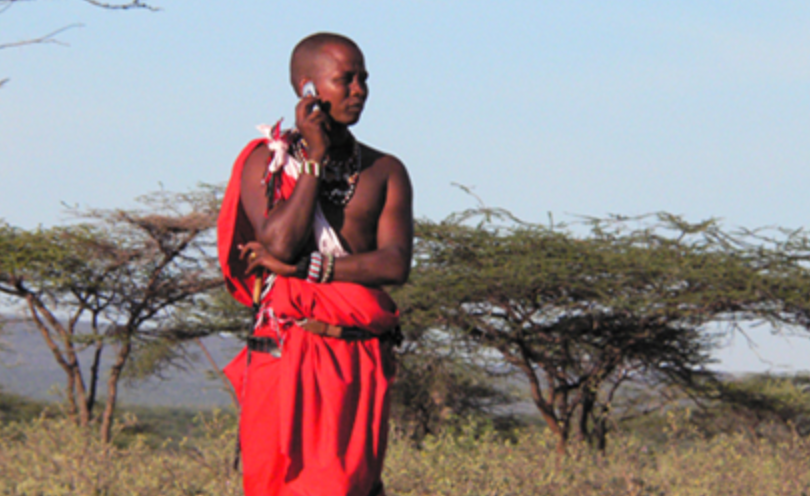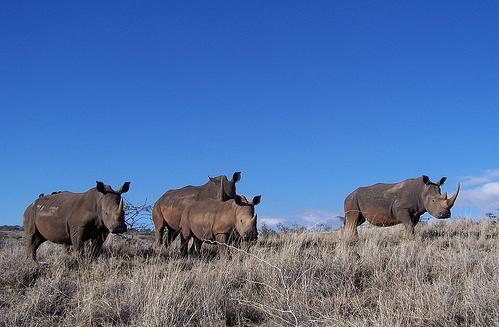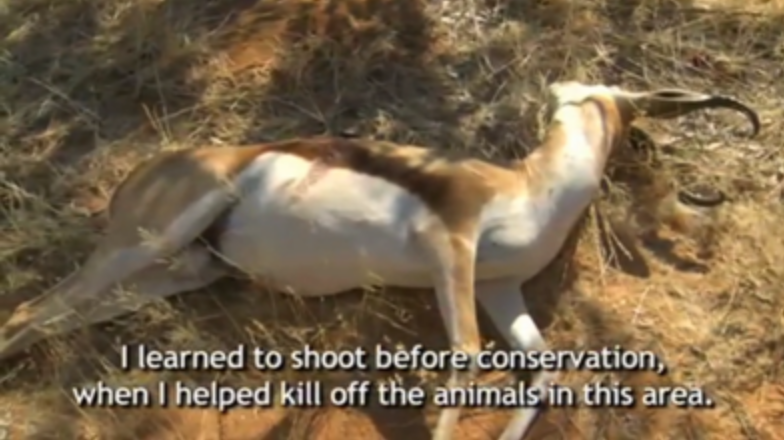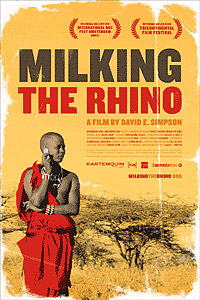David E. Simpson’s 2009 documentary Milking the Rhino is a groundbreaking, astonishing story of two cattle farming cultures, the Maasai of Kenya and Ovahimba of Namibia, caught between trying to conserve their ancient traditions amid the growing pressure of modern wildlife conservation. They represent the largely unseen inhabitants of the wildlife documentary, the conveniently ignored occupants of a land almost wholly seen as belonging to the wildlife itself, an untouched Edenic paradise that reinforces the crux of the modern tourism industry: the “myth of wild Africa”. Traditionally the wildlife posed very real threats to their co-inhabitants, a danger to life as well as competing with cattle for grazing, a land which became limited even further by the implementation of protected game reserves. The animals only became beneficial for the locals in terms of meat. The Massai and Ovahimba are forced to consider turning to tourism and community based conservation for survival, where they must radically re-orientate their relationship to the animals that surround them – to start “milking the rhino just like a cow”.
Western Wildlife
Milking the Rhino comes out of a long tradition of wildlife documentary film, a tradition largely rooted in the colonial past, where the lucrative poaching of wildlife gradually progressed into equally profitable conservation, and hence national parks, wildlife reserves and in turn African safaris were introduced. With the advent of great technological enhancement, the animal went from the object of the gun’s gaze to the object of a camera’s lens and watching these animals in their natural habitat from the comfort of our own (Western) homes became a possibility. The genre depends heavily on its “visual pleasure – vast landscape vistas, freely moving animals”. [1] This sublime landscape is often people-less, and as such lacks any significant markers of time – a pre-human age that takes the viewer out of the present day into a landscape devoid of the corrupting influence of civilisation, an “untroubled, untouched, unaltered nature – and as such [an] attractive tourist destination”(my emphasis). [2] These David Attenborough-type films reinforce the myth of the Edenic, natural paradise that is the African landscape. What Milking the Rhino does is directly engage with these tropes of wildlife filmmaking – the aesthetic as well as thematic – and by subverting them presents an alternate, demystified version of this otherwise isolated animal world, bringing it into modernity to reveal a harsh and bitter reality of a people who are losing their culture and are struggling to survive because of a Western ideal.
Milking the Tourist
The stock footage of free, roaming wildlife – the sublime landscape and the setting sun that frame the chase of predator and prey, or the poignant moment where a mother desperately protects her cubs from outsiders, quietly reminding us that we are not so different after all – is unhesitatingly and wholeheartedly left to the background. It is rather the people that make up this narrative, and animality itself becomes reduced to a discourse of debate rather than the source of visual splendour. Simpson reaches for a more accurate, objective portrayal of the land, of the people as well as its wildlife, where filmic stylistic techniques do not impede our view of the real world – documentary’s presentation of a manipulated actuality is discarded in favour of an attempt at a more unmediated reality. Through “formal devices – close-ups, point-of-view shots, reaction shots, etc., not to mention voice-over narration and dramatic music –” wildlife directors manipulate our reaction to the images on the screen, imbuing them with a powerful emotional force that is hard to resist, and thus the films’ often ecological concerns are more wholeheartedly felt by us as the viewing public. [3] Authorial intervention is thus limited through the rejection of these exact stylistic markers.
The opening sequence is not made up of an extended montage of these animals in all their visual delight, rather their initial presence is underplayed and often fleeting, powerfully juxtaposed next to images of the local people that live next to this wildlife, as well as a busy modern road of city traffic, immediately situating the film in the present day. The camera films the animals with a static safari-like distance from the ground, and there is a noticeable lack of narration – where there is voiceover it mostly serves objective narrative purposes, relaying factual information through the voice of Kenyan born Munyikombo Bukusi rather than attributing arbitrary character onto an unsuspecting animal. The Western subjectivity is disorientated and made strange by the stark portrayal of an unfamiliar human-animal relationship, crucially unquestioned by the filmmakers themselves. Hunting and killing, even a rock thrown in jest at a cow, are presented without a swelling score in the background to frame and reinforce our normally horrified response. Our Western ideal of conservation, naturalised through the narrow vision of wildlife films in these exact settings, is in this way unremorsefully destabilised. The emphasis lies more in the commonplace – the conversations that show us exactly how controversial and complex these issues actually are. The images of wildlife we are more accustomed to are used ironically, and the exaggerated score that couples the vivid colours are often relayed through archive footage while directly referencing the colonial past and the tourism industry that grew out of it.
Conservation can no longer be viewed as an unequivocally benevolent force, where its only source of conflict rises from the malevolent poacher. The discourse of commoditisation is itself also re-orientated, where our Western perspective, which may often see the problem of the animal as a binary between domesticity (pet-keeping, zoos etc. – animals as a commodity) and the freedom of their natural habitat, a simple polarity between human intervention and a supposed lack of interference in the wild, is deconstructed so that the presence of the animal becomes a question of survival. This is poignantly expressed through the title of the film itself – where for the cattle farming cultures of Massai and Ovahimba milking the rhino is a clever play on the most natural of all images, contrasting our connotations of exploitation and dubious money making schemes in the word milk. Viewing the animal as a commodity – the money to be made from wildlife tourism – becomes a necessity for these cultures, a natural progression from their similar objectification of cattle in order to make a living.
This radical relationship between animal and human is also pitted against an ironic and strangely uncomfortable reworking of the Western subjectivity. Our absolute awe at observing these amazing creatures in their natural habitat is wholly belittled by the disinterested – or even hostile –locals, as well as the tourist lodge owners who recognise the need to maintain the image of Africa as the untouched lands of myth, in other words, to recreate the image we see in a majority of wildlife film. The white manager of a tourist lodge in the Marienfluss Valley of Namibia articulates this desire in uncomfortably apt terms: tourists “have a picture in their head already. They want to discover a really remote place, and it is not a nice feeling when you’ve travelled all the way around the world and you can clearly see that 700 people have […] all left a mark on the place”. This is relayed over astonishing images of lodge workers sweeping the desert tyre tracks of a tourist vehicle. Tourists want the “real experience”, not a “set-up”, paradoxically only achieved through a deliberate construction – itself a “set-up” – of a timeless, prehistoric view of the landscape. The wildlife become a commodity for both tourist and local, and as such this cultural expectation of the “real experience” involves a partially constructed sublimity that is just as important as the animals themselves. An important aspect of this is the photograph. Locals were stopped burning nearby bushes, originally an act of self-protection against wild animals – the astounding logic was that the birds would not have anywhere to sit, and so “people [wouldn’t] be able to take good pictures”
Animal Ethics
The animals of this film are fundamentally considered through a discourse of benefit – “a rhino is no benefit to me”, so why should they try to protect it? At odds to a Western culture that tries to reinforce the intrinsic value of any living body, these tribes “need to see the value in wildlife in order to conserve it”. Presenting this differing set of ethical values to a primarily Western audience is unusual, according to Derek Bousé, who argues that “where clear cultural differences among humans do exist […], the meaning and value attached to the natural environment, [etc.]”, the mode of filmmaking will reflect the country of production and its audience. [4] There are cultural reasons why this version of Africa is not presented, and the film gets caught in a tension where it must reluctantly concede that generic subversion might serve little concrete benefit to anybody. To deconstruct the “the myth of wild Africa”, to show the Western safari-goer as an observed, half-strange Other on an ordinary landscape, alienates the tourist and ultimately harms the people whose only source of income has become dependent on this myth. The animal and in extension animal filmmaking thus have a cultural importance that transcends cinematic truth-telling, where, as Jonathan Burt recognises, the distinct “ethical language” of typical moralising wildlife narratives often privileges entertainment value against objective fact and “detached observation”. [5] This in itself does not take away from the power of this film, however, borne out of a radical representation of a people and their home that a colonial history traditionally denied. We come out of this film with a newfound appreciation of conservation’s complexities, and an understanding that even the most remote wild animals may not be exempt from the pressures and intricacies of civilisation.
Works Cited & Further Reading
Bousé, Derek, Wildlife Films (Philadelphia: University of Pennsylvania Press, 2000)
Burt, Jonathan, Animals in Film (London: Reaktion Books, 2002)
Chris, Cynthia, Watching Wildlife (Minneapolis: University of Minnesota Press, 2006)
Milking the Rhino. Dir. David E. Simpson. Kartemquin Films, 2009.
Milking the Rhino, Kartemquin Educational Films https://milkingtherhino.org/film.php [accessed 11 Jan 2015]
[1] Cynthia Chris, Watching Wildlife (Minneapolis: University of Minnesota Press, 2006), p. 46.
[2] Ibid., p. 60.
[3] Derek Bousé, Wildlife Films (Philadelphia: University of Pennsylvania Press, 2000), p.153.
[4] Bousé, Wildlife Films, p. 156.
[5] Jonathan Burt, Animals in Film (London: Reaktion Books, 2002), p. 92.




